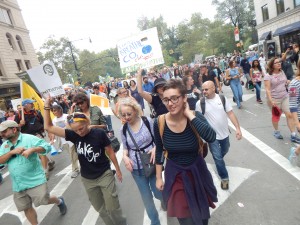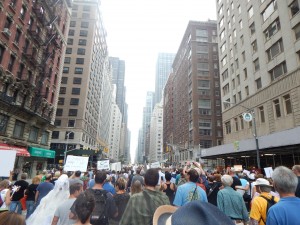LA&S on the March in New York City
A Special Report by Amanda Ruschak (’15, Public Relations/Sociology)
Imagine having the chance to become an active agent for change, putting what you’ve learned in the classroom into real life activism. For several busloads of SUNY New Paltz students, this dream became a reality at the People’s Climate March on Sept. 21.
The People’s Climate March occurred five days after an inspiring lecture at SUNY New Paltz by noted environmentalist and author Bill McKibben. McKibben, one of the organizers of the People’s Climate March, lectured about the ever-growing issue of climate change, calling it the “biggest crisis our civilization has ever faced.” With these words, he inspired students and members of the community alike to take part in what promoters of the event hoped would be the largest climate march in history.

Early on the morning of Sept. 21, almost 400 people on seven Greyhound buses departed from New Paltz. On these buses were New Paltz faculty and students, members of student organizations such as NYPIRG and Oxfam, the New Paltz Climate Action Coalition, and citizen activists of all ages.
There was electricity in the air as a group of New Paltz students lined up on Central Park Avenue and 72nd Street and became surrounded by many different marchers from all around the world in a sea of picket signs.
Dignitaries who took part in the march included McKibben, former vice president Al Gore, Jane Goodall, actor Edward Norton and U.N. Secretary General Ban Ki-moon. The march was divided into many different sections, with indigenous peoples accompanied by famous actor/activists Leonardo DiCaprio and Mark Ruffalo. Some other sections included a multi-faith group, which included Christians, Jewish and Islamic groups and several Buddhist monks. The march also contained many labor unions from all over the country, and according to the Huffington Post, as many as 50,000 students, including those from local universities like New Paltz, Bard and Vassar.

The marching procession swept as far forward and backward as the eye could see, with news helicopters constantly flying overhead covering the event. The streets were closed down, which was quite an interesting sight, with landmarks such as Columbus Circle, Trump International Hotel and Tower, and Radio City Music Hall surrounded by thousands of protesters, and the sound of cheering voices in place of the usual NYC sound of honking taxis and commuters. There were innumerable colorful signs, floats and flags. With groups like Oxfam chanting, “What do we want? Climate Justice! When do we want it? Now!,” there was never any sort of silence.
The People’s Climate March was a valuable opportunity for New Paltz to be represented through student activism. My fellow students and I became firsthand activists on issues that concern us. Sociology major Katie Drao said she partakes in activism because she would like “nothing more than to make a difference in this world.” She observed much “positive energy” at the march.
“I saw no negativity or heckling; it was a friendly and peaceful protest,” she said.
Not only is activism beneficial for students, it sends a message to the people who helped shape the values that are the foundation of our activism.
Sociology professor Peter Kaufman serendipitously ran into a number of sociology alumni at the march. He remarked that as an educator, it was “great to see these students doing sociology and conveying to me how their education at New Paltz [has] shaped them into being the type of citizen activists that are working for a better tomorrow.”
